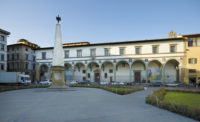Monterrey, Mexico
You can tell a lot about a place by the kind of postcards offered for sale there. The ones in Monterrey, Mexico, the capital city of the northeastern state of Nuevo Leon and the country’s industrial center, picture historic steel works, beer from the local breweries, and the “Lighthouse of Commerce” monument in the center of town. It seems fitting then, that a new steel museum, Museo Del Acero Horno³, built in and around a decommissioned blast furnace, has emerged as a new focal point for the region. It is one component of the city’s larger transformation of the surrounding 275-acre industrial campus into a public park, Parque Fundidora, which includes the renovation of numerous industrial structures into cultural forums and the like. The project, part adaptive-reuse and part new construction, is also particularly well-suited to its British architect, Nicholas Grimshaw—who attributes his formative early involvement with industrial projects in part to his roots: One of his grandfathers was a dam builder in Egypt, the other a physician and public health inspector in Dublin who arranged for the installation of the city’s drainage system.
According to locals, the 230-foot-high blast furnace, the third and newest on the site, which operated from 1968–86, was the swan song of the foundry, Compañia Fundidora de Fierro y Acero de Monterrey. It has sat abandoned since the company went bankrupt and shut its doors overnight. Responding to an RFP sent out by Patronato Museo del Acero, a government- and privately funded nonprofit organization formed to turn the crumbling structure into a museum, local architects Oficina de Arquitectura partnered up with London-based Grimshaw Architects and were awarded the commission in 2005, just 24 months before the scheduled opening set to coincide with the 2007 Universal Forum of Cultures. To create the museum, the architects adapted the cast hall, the furnace itself, its workings, and its surrounding infrastructure, and added 34,000 square feet of new space for additional exhibitions, workshops, education, and archives.
The yearlong first phase of the project focused on stabilizing, cleaning, and treating the existing structure. It was “almost unsurveyable,” says Grimshaw associate principal William Horgan. “There was so much existing ironwork and not a single level surface.” Minimal intervention was needed for the steel structure, say the architects, since the load demand as a museum would be much less than it had been as a working foundry. The challenge came in preserving enough original fabric of historical, engineering, or museological significance to tell Horno3’s story, while making space for a new architectural program. Elements that were retained, such as the furnace itself, catwalks, and much of the original steel structure, were treated for surface corrosion: Oxidization was removed and the steel was encapsulated in an epoxy-based sealant and then coated with a clear, matte polyurethane. Though freshened up, these artifacts help preserve the gritty aesthetic from the building’s former life.
With the furnace as the central organizing hub, the museum consists of a collection of discrete elements: a new entry wing, a new circular Steel Gallery, the massive Cast Hall, and offices and a café located in the former hoist room and control room, respectively. Soaring into the sky is an iron-ore elevator, retrofitted with an funicularlike cab, which rises 140 feet up to a network of original exterior catwalks that weave around the furnace, its pipes, and its stoves, offering visitors a vertiginous tour and views out to the city, nearby Saddle Mountain, the Sierra Madre Oriental mountain range, and down the furnace into Horno³’s belly.


